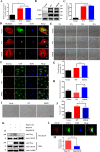Effects of a novel ANLN E841K mutation associated with SRNS on podocytes and its mechanism
- PMID: 37957688
- PMCID: PMC10644598
- DOI: 10.1186/s12964-023-01218-w
Effects of a novel ANLN E841K mutation associated with SRNS on podocytes and its mechanism
Abstract
Background: Steroid-resistant nephrotic syndrome (SRNS) is characterized by unrelieved proteinuria after an initial 4-8 weeks of glucocorticoid therapy. Genes in podocytes play an important role in causing SRNS.
Objective: This study aimed to report a pathogenic mutation in SRNS patients and investigate its effects on podocytes, as well as the pathogenic mechanism.
Methods: We screened out a novel mutation by using whole-exon sequencing in the SRNS cohort and verified it via Sanger sequencing. Conservative analysis and bioinformatic analysis were used to predict the pathogenicity of the mutation. In vitro, stable podocyte cell lines were constructed to detect the effect of the mutation on the function of the podocyte. Moreover, an in vivo mouse model of podocyte ANLN gene knockout (ANLNpodKO) was used to confirm clinical manifestations. Transcriptome analysis was performed to identify differential gene expression and related signaling pathways.
Results: ANLN E841K was screened from three unrelated families. ANLN E841K occurred in the functional domain and was predicted to be harmful. The pathological type of A-II-1 renal biopsy was minimal change disease, and the expression of ANLN was decreased. Cells in the mutation group showed disordered cytoskeleton, faster cell migration, decreased adhesion, increased endocytosis, slower proliferation, increased apoptosis, and weakened interaction with CD2 association protein. ANLNpodKO mice exhibited more obvious proteinuria, more severe mesangial proliferation, glomerular atrophy, foot process fusion, and increased tissue apoptosis levels than ANLNflox/flox mice after tail vein injection of adriamycin. Upregulated differentially expressed genes in cells of the mutation group were mainly enriched in the PI3K-AKT pathway.
Conclusion: The novel mutation known as ANLN E841K affected the function of the ANLN protein by activating the PI3K/AKT/mTOR/apoptosis pathway, thus resulting in structural and functional changes in podocytes. Our study indicated that ANLN played a vital role in maintaining the normal function of podocytes. Video Abstract.
Keywords: ANLN mutation; Podocyte; Podocyte-specific knockout mouse; SRNS.
© 2023. The Author(s).
Conflict of interest statement
The authors declare no competing interests.
Figures





Similar articles
-
The Human FSGS-Causing ANLN R431C Mutation Induces Dysregulated PI3K/AKT/mTOR/Rac1 Signaling in Podocytes.J Am Soc Nephrol. 2018 Aug;29(8):2110-2122. doi: 10.1681/ASN.2017121338. Epub 2018 Jul 12. J Am Soc Nephrol. 2018. PMID: 30002222 Free PMC article.
-
[Role of podocyte injury signaling pathway in steroid-resistant nephrotic syndrome and research progress in traditional Chinese medicine intervention].Zhongguo Zhong Yao Za Zhi. 2023 Jun;48(12):3246-3254. doi: 10.19540/j.cnki.cjcmm.20230313.601. Zhongguo Zhong Yao Za Zhi. 2023. PMID: 37382008 Review. Chinese.
-
Use of genomic and functional analysis to characterize patients with steroid-resistant nephrotic syndrome.Pediatr Nephrol. 2018 Oct;33(10):1741-1750. doi: 10.1007/s00467-018-3995-2. Epub 2018 Jul 7. Pediatr Nephrol. 2018. PMID: 29982877
-
KANK deficiency leads to podocyte dysfunction and nephrotic syndrome.J Clin Invest. 2015 Jun;125(6):2375-84. doi: 10.1172/JCI79504. Epub 2015 May 11. J Clin Invest. 2015. PMID: 25961457 Free PMC article.
-
Hiding in plain sight: genetics of childhood steroid-resistant nephrotic syndrome in Sub-Saharan Africa.Pediatr Nephrol. 2023 Jul;38(7):2003-2012. doi: 10.1007/s00467-022-05831-8. Epub 2022 Dec 2. Pediatr Nephrol. 2023. PMID: 36459247 Free PMC article. Review.
Cited by
-
Swollen Feet: Considering the Paradoxical Roles of Interleukins in Nephrotic Syndrome.Biomedicines. 2024 Mar 26;12(4):738. doi: 10.3390/biomedicines12040738. Biomedicines. 2024. PMID: 38672094 Free PMC article. Review.
-
Signaling, cancer cell plasticity, and intratumor heterogeneity.Cell Commun Signal. 2024 May 3;22(1):255. doi: 10.1186/s12964-024-01643-5. Cell Commun Signal. 2024. PMID: 38702718 Free PMC article.
References
-
- Trautmann A, Vivarelli M, Samuel S, Gipson D, Sinha A, Schaefer F, Hui NK, Boyer O, Saleem MA, Feltran L, et al. IPNA clinical practice recommendations for the diagnosis and management of children with steroid-resistant nephrotic syndrome. Pediatr Nephrol. 2020;35:1529–1561. doi: 10.1007/s00467-020-04519-1. - DOI - PMC - PubMed
Publication types
MeSH terms
Substances
LinkOut - more resources
Full Text Sources
Molecular Biology Databases
Miscellaneous

